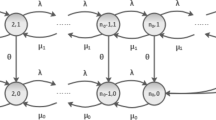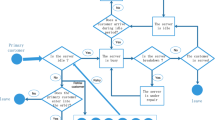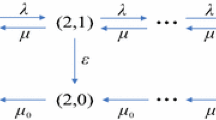Abstract
This paper considers an almost observable unreliable \(M_{n}{/}G{/}1\) queueing system in which the arriving customers can observe the queue length upon their arrivals but not the state of the server. The arrival rates are state-dependent and the server is subject to breakdowns when it works. The lifetime of the server and the repair time are independent, and they follow two different general distributions. To obtain the steady-state queue length distribution, we present an auxiliary system called modified \(M_{n}{/}G{/}1\) queueing system. Comparing the unreliable system with the modified system, we derive the steady-state queue length distributions at the arrival instant of a tagged customer. Moreover, we study customers’ equilibrium joining strategies based on a nonlinear waiting cost function. These results provide managerial insights into strategic behaviors of customers.



Similar content being viewed by others
References
Anthony C (2000) Individual equilibrium dynamic routing in a multiple server retrial queue. Probab Eng Inf Sci 14:9–26
Atencia I (2015) A discrete-time queueing system with server breakdowns and changes in the repair times. Ann Oper Res 235:37–49
Atencia I, Moreno P (2006) A discrete-time Geo/G/1 retrial queue with server breakdowns. Asia Pac J Oper Res 23:247–271
Atencia I, Bouza G, Moreno P (2008) An \(M^{[X]}/G/1\) retrial queue with server breakdowns and constant rate of repeated attempts. Ann Oper Res 157:225–243
Avi-Itzhak B, Naor P (1962) Some queueing problems with the service station subject to breakdown. Oper Res 10:303–320
Boudali O, Economou A (2012) Optimal and equilibrium balking strategies in the single server Markovian queue with catastrophes. Eur J Oper Res 218:708–715
Burnetas A, Economou A (2007) Equilibrium customer strategies in a single server Markovian queue with setup times. Queueing Syst 56:213–228
Choudhury G, Tadj L (2009) An \(M{/}G{/}1\) queue with two phases of service subject to the server breakdown and delayed repair. Appl Math Model 33:2699–2709
Cui S, Su X, Veeraraghavan SK (2014) A model of rational retrials in queues. Working paper
Economou A, Kanta S (2008) Equilibrium balking strategies in the observable single server queue with breakdowns and repairs. Oper Res Lett 36:696–699
Economou A, Kanta S (2011) Equilibrium customer strategies and social-profit maximization in the single-server constant retrial queue. Nav Res Log 58:107–122
Economou A, Manou A (2015) A probability approach for the analysis of the \(M_n/G/1\) queue. Ann Oper Res. https://doi.org/10.1007/s10479-015-1943-0
Elcan A (1994) Optimal customer return rate for an \(M/M/1\) queueing system with retrials. Probab Eng Inf Sci 8:521–539
Feller W (1971) An introduction to probability theory and its applications, vol II, 3rd edn. Wiley, New York
Gibbons R (1992) A primer in game theory. Harvester Wheatsheaf, Birmingham
Gray WJ, Wang P, Scott M (2000) A vacation queueing model with service breakdowns. Appl Math Model 24:391–400
Guo P, Hassin R (2011) Strategic behavior and social optimization in Markovian vacation queues. Oper Res 59:986–997
Guo P, Zipkin P (2007) Analysis and comparision of queues with different levels of delay information. Manag Sci 53:962–970
Hassin R, Haviv M (2002) Nash equilibrium and subgame perfection in observable queues. Ann Oper Res 113:15–26
Hassin R, Haviv M (2003) To queue or not to queue. Springer, Berlin
Jain M, Jain A (2010) Working vacations queueing model with multiple types of server breakdowns. Appl Math Model 34:1–13
Jayaraman D, Nadarajan R, Sitrarasu MR (1994) A general bulk service queue with arrival rate dependent on server breakdowns. Appl Math Model 18:156–160
Ke JC (2006) On \(M{/}G{/}1\) system under NT policies with breakdowns, startup and closedown. Appl Math Model 30:49–66
Ke JC (2007) Batch arrival queues under vacation policies with server breakdowns and startup/closedown times. Appl Math Model 31:1282–1292
Kerner Y (2008) The conditional distribution of the residual service time in the \(M_n/G/1\) queue. Stoch Mod 24:364–375
Kerner Y (2011) Equilibrium joining probabilities for an \(M{/}G{/}1\) queue. Games Econ Behav 71:521–526
Kim BK, Lee DH (2014) The \(M{/}G{/}1\) queue with disasters and working breakdowns. Appl Math Model 38:1788–1798
Krishnamoorthy A, Pramod PK, Chakravarthy SR (2014) Queues with interruptions: a survey. TOP 22:290–320
Kulkarni VG (1983) A game theoretic model for two types of customers competing for service. Oper Res Lett 2:119–122
Kulkarni VG, Choi BD (1990) Retrial queues with server subject to breakdowns and repairs. Queueing Syst 7:191–208
Lee DH, Yang Ws, Park HM (2011) \(Geo/G/1\) queues with disasters and general repair times. Appl Math Model 35:1561–1570
Li Q, Ying Y, Zhao YQ (2006) A \(BMAP/G/1\) retrial queue with a server subject to breakdowns and repairs. Ann Oper Res 141:233–270
Lin CH, Ke JC (2011) On the discrete-time system with server breakdowns: computational algorithm and optimization algorithm. Appl Math Comput 218:3624–3634
Maister DH (1985) The psychology of waiting lines. In: Czepiel JA, Soloman M, Surprenant CS (eds) The service encounter. Lexington Books, Lexington
Mitrany JL, Avi-Itzhak B (1968) A many server queue with server interruptions. Oper Res 16:628–638
Naor P (1969) The regulation of queue size by levying tolls. Econometrica 37:15–24
Sabri-Laghaie K, Mansouri M, Motaghedi-Larijani A, Jalali-Naini G (2012) Combining a maintenance center \(M/M/c/m\) queue into the economic production quantity model with stochastic machine breakdowns and repair. Comput Ind Eng 63:864–874
Thiruvenydan K (1963) Queueing with breakdown. Oper Res 11:62–71
Vinck B, Bruneela H (2006) System delay versus system content for discrete-time queueing systems subject to server interruptions. Eur J Oper Res 175(1):362–375
Wang J, Zhang P (2009) A single-server discrete-time retrial G-queue with server breakdowns and repairs. Acta Math Appl Sin E 25:675–684
Wang J, Zhang F (2011) Equilibrium analysis of the observable queues with balking and delayed repairs. Appl Math Comput 218:2716–2729
Wang J, Zhang F (2013) Strategic joining in \(M/M/1\) retrial queues. Eur J Oper Res 230:76–87
Wang J, Cao J, Li Q (2001) Reliability analysis of the retrial queue with server breakdowns and repairs. Queueing Syst 38:363–380
Wang KH, Chan MC, Ke JC (2007a) Maximum entropy analysis of the \(M^{[x]}/M/1\) queueing system with multiple vacations and server breakdowns. Comput Ind Eng 52:192–202
Wang KH, Wang TY, Pearn WL (2007b) Optimal control of the \(N\) policy \(M{/}G{/}1\) queueing system with server breakdowns and general startup times. Appl Math Model 31:2199–2212
White H, Christie L (1958) Queuing with preemptive priorities or with breakdown. Oper Res 6:79–95
Zhang F, Wang J, Liu B (2012) On the optimal and equilibrium retrial rates in an unreliable retrial queue with vacations. J Ind Manag Optim 8:861–875
Author information
Authors and Affiliations
Corresponding author
Additional information
Supported by the National Natural Science Foundation of China (71571014 and 71390334).
Appendix
Appendix
Proof of Lemma 3.1
By the definition of distribution function, we have
where \(\Psi _t(z)=Pr(N(t)\le z)=\sum _{i=0}^{z}P_{t}(i)\). Since \(Y_{ij}\sim G(x),i,j \in Z^{+}\), in virtue of the convolution formula, we get
This completes the proof. \(\square \)
Proof of Lemma 3.2
(1) The mean service time in modified \(M_n{/}G{/}1\) system can be computed by
The number of breakdowns \(N(X_{i})\) is independent of \(Y_{ij}, j=1,2,\ldots , N(X_{i})\), then (7.2) can be rewritten as
Since \(Y_{ij}, j=1,2,\ldots , k\) are i.i.d random variables with the common mean value \(\gamma _{1}\), we have that
where the last equation is by the total probability formula.
(2) According to the definition of the modified system, we know that the conditional mean remaining service time at the arrival instant of a tagged customer who finds n customers in the modified system is identical to the generalized conditional mean remaining service time in the unreliable system. This completes the proof. \(\square \)
Proof of Lemma 4.3
(1) By the definition of distribution, we have
Next we prove that \(\lim \limits _{\alpha \rightarrow 0}\Pr (X_{i}+\sum _{j=1}^{N({X_{i})}}Y_{ij} \le x, N(X_{i})\ne 0)=0\).
and
Since \(e^{-x\alpha }>0\) and \(\int _{0}^{\infty }|e^{-x\alpha }|dB(y)<\infty \), we get
Hence \(\lim \limits _{\alpha \rightarrow 0}\Pr (X_{i}+\sum _{j=1}^{N(X_{i})}Y_{ij} \le x, N(X_{i})\ne 0)=0\). From (7.3), we immediately obtain the following equation:
According to the multiplication rule of probability, we get
Because \(N(X_{i})\) is independent of \(X_{i}\), and \(\Pr (N(X_{i})=0)=1-\Pr ( N(X_{i})\ne 0)=1\), then we obtain \(\lim \limits _{\alpha \rightarrow 0}\hat{B}(x)= \Pr (X_{i} \le x)=B(x)\). By the Continuity Theorem (see Feller 1971), we have
We obtain Lemma 4.3 (1). This completes the proof. \(\square \)
(2) First we will prove that \(\lim \limits _{\theta \rightarrow \infty }\Pr (Y_{ij}\ne 0)=0\). Proof by contradiction is adopted.
Suppose that \(\lim \limits _{\theta \rightarrow \infty }\Pr (Y_{ij}\ne 0)\ne 0\), it is readily seen that \(\lim \limits _{\theta \rightarrow \infty }E(Y_{ij})>0\) since \(Y_{ij}\ge 0\) and \(\Pr (Y_{ij}\ne 0)\ne 0\). However, the repair times follow an exponential distribution with rate \(\theta \), which means \(E(Y_{ij})=\frac{1}{\theta }\), and then \(\lim \limits _{\theta \rightarrow \infty }E(Y_{ij})=0\), which conflicts with \(\lim \limits _{\theta \rightarrow \infty }E(Y_{ij})>0\). Hence the assumption that \(\lim \limits _{\theta \rightarrow \infty }\Pr (Y_{ij}\ne 0)\ne 0\) is not true, and we obtain the fact that \(\lim \limits _{\theta \rightarrow \infty }\Pr (Y_{ij}\ne 0)=0\).
According to the property of complementary events, we have \(\lim \limits _{\theta \rightarrow \infty }\Pr (Y_{ij}= 0)=1\). On the other hand,
From (7.8), we have
Since \(\sum _{k=0}^{\infty } \left( 1-\Pr \left( \sum _{j=1}^{k}Y_{ij}=0\right) \right) \frac{(x\alpha )^{k} e^{-x\alpha }}{k!}>0\) and
Equation (7.9) can be rewritten as
Since \(Y_{ij}\ge 0\), \(\lim \limits _{\theta \rightarrow \infty }\Pr ( \sum _{j=1}^{k}Y_{ij}=0)=\lim \limits _{\theta \rightarrow \infty }\prod _{i=0}^{k}\Pr ( Y_{ij}=0)=1\). This completes the proof. \(\square \)
(3) By the definition of distribution function, we have
which is identical to the following equation:
Next we prove that \(\lim \limits _{\theta \rightarrow \infty }\Pr (X_{i}+\sum _{j=1}^{N(X_{i})}Y_{ij} \le x, \sum _{j=1}^{N(X_{i})}Y_{ij}\ne 0)=0\). Evidently,
From Lemma 4.3 (2), we have
which implies that \(\lim \limits _{\theta \rightarrow \infty }\Pr (X_{i}+\sum _{j=1}^{N(X_{i})}Y_{ij} \le x, \sum _{j=1}^{N(X_{i})}Y_{ij}\ne 0)=0\). Then (7.12) can be rewritten as
Since \(X_{i}\) is independent of \(Y_{ij}, j=1,2,\ldots , N(X_{i})\), Eq. (7.15) becomes
From Lemma 4.3 (2), we know that \( \lim \limits _{\theta \rightarrow \infty }\Pr (\sum _{j=1}^{N(X_{i})}Y_{ij}=0)=1- \lim \limits _{\theta \rightarrow \infty }\Pr (\sum _{j=1}^{N(X_{i})}Y_{ij}\ne 0)=1\), and then the following equation holds:
In virtue of Continuity Theorem (see Feller 1971), the proof is completed. \(\square \)
Rights and permissions
About this article
Cite this article
Zhu, S., Wang, J. & Liu, B. Equilibrium joining strategies in the Mn/G/1 queue with server breakdowns and repairs. Oper Res Int J 20, 2163–2187 (2020). https://doi.org/10.1007/s12351-018-0407-0
Received:
Revised:
Accepted:
Published:
Issue Date:
DOI: https://doi.org/10.1007/s12351-018-0407-0




